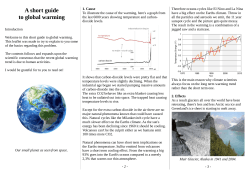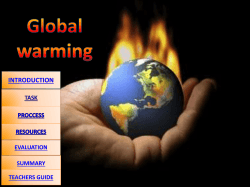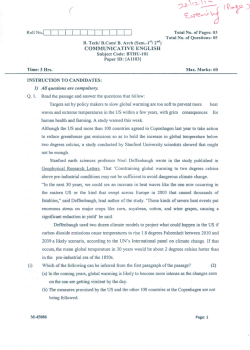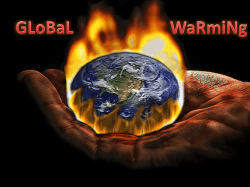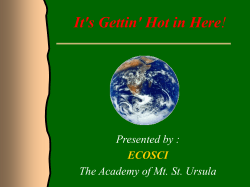
Lost and found: Earth`s missing heat
Downloaded from www.sciencemag.org on June 6, 2015 IN DEP TH CLIMATE SCIENCE Lost and found: Earth’s missing heat note, 1998 was a particularly strong (and hot) El Niño year—not an ideal starting point for determining a subsequent trend. But the temperature data themselves— collected by a variety of techniques from land and sea—have also been a source of concern, says Thomas Karl, director of the National Oceanic and Atmospheric Administration’s National Climatic Data Center in Asheville, North Carolina, and the lead author on the new paper published online this week in Science (http://scim.ag/TKarl). Climate scientists have worked for years to improve corrections for bias in the data. “It’s an ongoing activity,” Karl says. Creating a single, self-consistent, longterm record of sea surface temperature (SST) has proven especially tricky. For much of the past 2 centuries, ocean temperatures were measured from ships, by means of a bucket thrown over the side. Different fleets used hat if the missing heat has been different measurement techniques and, over there all along? In 2013, the Intertime, various types of buckets—first wooden governmental Panel on Climate ones, then specially designed canvas ones. Change (IPCC) flagged an odd pheEventually, buckets gave way to ship engine nomenon: Atmospheric temperaintake measurements, taken when water was ture data collected over the past brought in to cool the machinery. And by the few decades suggested that global warming end of the 20th century, far more accurate had slowed down beginning around 1998. buoy measurements took over. Each techGlobal warming skeptics crowed, and sciennique required different corrections. tists delved into the global climate system to Another challenge was incorporating landfind out where the missing heat had gone. based readings from thousands of new meaBut a new analysis suggests that the real culsurement stations in regions that have long prits are the data themselves. When better had scant coverage, particularly Asia, South corrections for various sources of bias are America, and Africa. New data from these applied to the data, the authors say, the soregions have been amassed over the past called global warming hiatus vanishes—and 5 years as part of the International Surface in fact, they argue, global warming may have Temperature Initiative, which released its sped up. first report just last year. That won’t startle some scientists, In their paper, Karl’s team sums who say the “hiatus” was always a up the combined effect of additional Vanishing hiatus misnomer. “There is no hiatus or land temperature stations, corrected New data and corrections for bias suggest global warming pause,” says climate scientist Michael commercial ship temperature data, rates (squares) are higher than scientists thought (circles). Mann of Pennsylvania State Univerand corrected ship-to-buoy calibrasity, University Park, who prefers the tions. The group estimates that the 0.3 term “temporary slowdown.” But he world warmed at a rate of 0.086°C and others do think something has per decade between 1998 and 2012— 0.2 changed since the late 1990s: Perhaps more than twice the IPCC’s estimate 0.1 the deep waters of the Pacific and Atof about 0.039°C per decade. The lantic oceans are storing more heat, or new estimate, the researchers note, 0 volcanic eruptions and pollution have is much closer to the rate of 0.113°C been shading the planet and offsetper decade estimated for 1950 to 1999. −0.1 Global Ocean Land ting the warming. What’s more, they And for the period from 2000 to 2014, By Carolyn Gramling Warming (degrees/ decade, 1998−2014) W 1066 sciencemag.org SCIENCE 5 JUNE 2015 • VOL 348 ISSUE 6239 Published by AAAS CREDITS: (PHOTO) CLAUDIA KÜNKEL; (DATA) KARL ET AL. (ADVANCED ONLINE PUBLICATION, 4 JUNE) A reanalysis of surface temperatures suggests there never was a global warming hiatus NEWS PHOTO: © ITAR-TASS PHOTO AGENCY/ALAMY Buoys, such as this 3-meter discus buoy beached in California, provide temperature data worldwide. the new analysis suggests a warming rate of 0.116°C per decade—slightly higher than the 20th century rate. “What you see is that the slowdown just goes away,” Karl says. And that’s without including the elephant in the room: Arctic warming. A 2014 paper in the Quarterly Journal of the Royal Meteorological Society highlighted how the scarcity of temperature data from the Arctic, which is warming twice as fast as the rest of the planet, has produced a significant “cool” bias in the global trends, especially since 1997. “The post-1998 period is really difficult, partially because of Arctic warming and partly because of the change in SST measurements,” says Kevin Cowtan, a computational scientist at the University of York in the United Kingdom, who co-authored the 2014 paper. “The fact that it’s caused problems is completely understandable, if unfortunate.” To estimate how Arctic warming might alter global trends, Karl’s team used a nonlinear technique to fill in the data gaps for the polar region. Including the Arctic, they found, would add between 0.02°C and 0.03°C of warming per decade. Karl notes that this is just an estimate, however, and wasn’t included in the paper’s final reanalysis of recent warming. Not everyone agrees that the 21st century slowdown is entirely a data artifact. Mann notes that there is “very clear” evidence of a slowdown in large-scale warming in the tropical Pacific; in a previous paper, he and others linked it to a natural decades-long climate pattern that brought about La Niña– like cooler conditions in the past decade (Science, 27 February, p. 988). “The tropical Pacific definitely warmed less over that time period than climate models had predicted,” Mann says. Cowtan agrees, adding that there are a lot of lingering uncertainties in the data, particularly in the Arctic, as well as in some of the shipboard corrections during the last century. “My feeling is, they’ve got the right answer—but not for quite the right reasons,” Cowtan says. “My guess is there’s a little bit too much ocean warming [in their calculations], and not enough from the Arctic.” Karl says his team is planning ways to address the Arctic temperature issue next. He also says research into the slowdown has spurred important insights that help clarify the global climate system. “Global temperatures might have been even warmer than we’re reporting had some of these other factors not come into play,” Karl says. “And once these things play out, we may find we’re warming at an even more rapid rate than we saw at the end of the last century.” ■ SCIENCE POLICY Russian foundation tarred with ‘foreign’ label Founder may pull plug on private research funder By Vladimir Pokrovsky, in Moscow W rapping up a postdoc in Italy in 2003, Sergei Popov faced a dilemma. The astrophysicist wanted to return to his native Russia but received “quite a good offer” to stay abroad. He was about to accept it, he says, when Russia’s only private research funder, the Dynasty Foundation, offered him a ticket home: a grant for young Ph.D.s. “It’s owing to Dynasty that I still work in Russia,” says Popov, a specialist on neutron stars here at the Sternberg Astronomical Institute. But Dynasty’s days are numbered. Last week, Russia’s Justice Ministry branded the foundation a “foreign agent.” The move threatens to strangle the foundation in red tape, and, Popov says, future Dynasty grantees would effectively be ostracized. The designation infuriates Dynasty’s founder, telecom tycoon Dmitry Zimin. Reached by phone, he told Science that he would simply “stop financing the foundation.” That prospect is sending shock waves through the scientific community. “The main thing that we have lost is hope,” says Valery Rubakov, a physicist here at the Russian Academy of Sciences’ (RAS’s) Institute for Nuclear Research. One of Russia’s top biologists—Mikhail Gelfand of RAS’s Institute for Information Transmission Problems—and other prominent researchers have vowed to stage a rally here on 6 June to protest the government’s “disrespect to science and education” and “consistent elimination of the seedlings of civil society.” Zimin, a co-founder of the national cellular network VimpelCom, set up Dynasty in 2002. Each year since then, he says, he has transferred about $10 million of his fortune to Dynasty. The Moscow-based foundation last year spent that sum on 20 projects supporting young researchers (mainly mathematicians and physicists), competitions for science teachers, science festivals, and public lectures by world-class researchers. As part of a campaign to crack down on nongovernmental organizations focused on human rights and free elections, the Russian government in July 2012 adopted the foreign agent law, which piles reporting requirements on designated organizations and compels them to label anything they produce, SCIENCE sciencemag.org from conferences to reports, as foreign agent activities. Since then, 67 organizations have been caught in the dragnet. Some have shuttered operations in Russia, and others are fighting the designation. In labeling Dynasty a foreign agent, officials cited its funding from offshore accounts owned by Zimin. At a press conference called last week after Dynasty’s designation drew widespread condemnation, Justice Minister Alexander Konovalov stood firm. “We do not exclude that there were positive motives for the foundation’s activities,” he said, “but that does not exclude the necessity to imple- Dmitry Zimin is livid over foreign agent label. ment the law.” Nor is it likely that Russian President Vladimir Putin will overrule him. Putin’s spokesman, Dmitry Peskov, declared last week that if Dynasty “gets money from abroad, then it is a foreign agent.” The government is not forcing Dynasty to close, Peskov added: That’s Zimin’s decision, he said. Dynasty officials plan to meet on 8 June to decide the foundation’s fate. In a letter last week to Russian scientists, Zimin wrote, “I or my heirs will renew and maybe even broaden these activities as soon as our existence in our country will become more civilized.” Dynasty had an outsized impact on Russian science, researchers say. “My personal feeling is that Dynasty made a bigger contribution than the whole state,” says Boris Shtern of the RAS Institute for Nuclear Research. “Many rich people invest their money in sports clubs, in yachts, and only one of them invests in his own country’s science and education,” he continues. “The country has never known this kind of absurdity.” ■ 5 JUNE 2015 • VOL 348 ISSUE 6239 Published by AAAS 1067
© Copyright 2025
